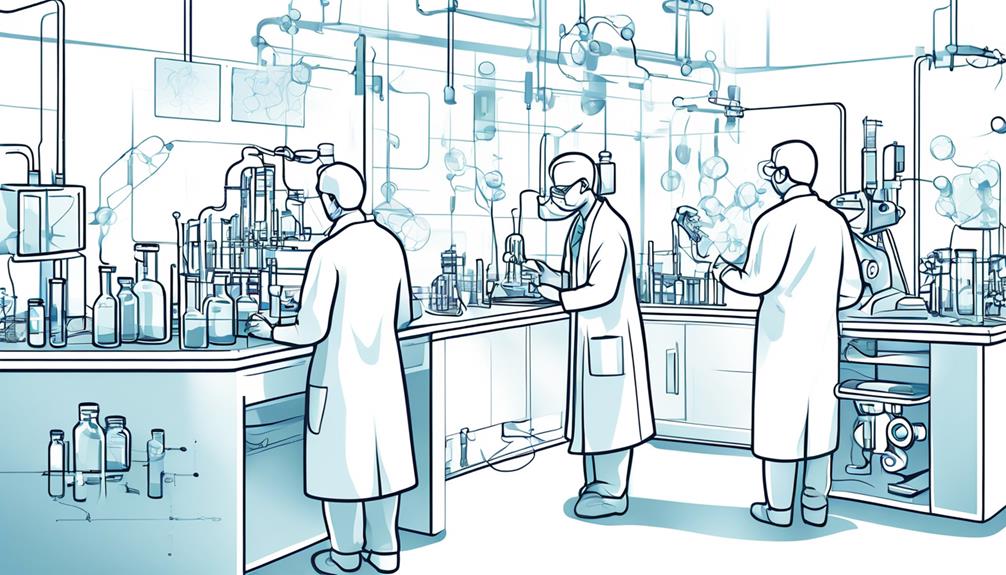7 Revolutionary Advances in Regenerative Medicine
You may be familiar with the groundbreaking work of Dr. Anthony Atala, who successfully 3D printed a human kidney in 2019.
But did you know that this is just one of the seven revolutionary advances in regenerative medicine that have the potential to reshape the future of healthcare?
These cutting-edge technologies and approaches are not only transforming the way we think about treating diseases and injuries, but they also hold the promise of personalized and regenerative therapies that could change the lives of millions.
Curious to learn more about these groundbreaking advances and their potential impact on healthcare?
Key Takeaways
- Stem cell therapy and tissue engineering have become essential in regenerative medicine, offering potential treatments for genetic and degenerative disorders, age-related functional defects, immune system disorders, heart failures, and cancers.
- Gene editing, particularly with CRISPR-Cas9, is a revolutionary tool for treating genetic disorders and modifying traits, although it raises ethical implications and safety concerns. Exosome therapy is also being investigated for tissue repair and regeneration, particularly in treating tissue injuries, neurodegenerative diseases, and autoimmune disorders.
- Growth factors, such as Transforming Growth Factor-Beta (TGF-β), Fibroblast Growth Factor (FGF), and Epidermal Growth Factor (EGF), play a pivotal role in tissue repair and regeneration by stimulating cell proliferation and differentiation, aiding in blood vessel formation, reducing scar formation, and promoting effective tissue repair.
- Advances in understanding cell regeneration mechanisms, particularly through stem cell therapy, offer the potential for life-saving treatments in tissue repair, age-related defects, immune disorders, heart failures, and cancers. Regenerative medicine holds promise for revolutionizing disease management, but safety concerns in stem cell research and genome editing need careful consideration, and policymakers play a crucial role in supporting the field.
Stem Cell Therapy
Stem cell therapy is rapidly becoming an essential component of regenerative medicine, offering groundbreaking potential for treating a wide range of genetic and degenerative disorders.
The ability of stem cells to differentiate into various cell types makes them a promising treatment for conditions such as age-related functional defects, immune system disorders, heart failures, and cancers. This revolutionary approach has the potential to address previously untreatable conditions, providing hope for patients and healthcare professionals alike.
Despite the tremendous promise of stem cell therapy, ethical concerns have been raised regarding the source of stem cells, particularly embryonic stem cells. However, recent advances in technology have shifted the focus towards adult stem cells and induced pluripotent stem cells, which can be obtained without ethical concerns.
Looking to the future, the prospects of stem cell therapy are incredibly exciting. Ongoing research and clinical trials are continuously expanding the scope of conditions that can be treated using stem cell-based therapies.
As our understanding of stem cells deepens, the potential for personalized and targeted treatments for a myriad of diseases continues to grow, paving the way for a new era in regenerative medicine.
Tissue Engineering
The potential of regenerative medicine extends beyond stem cell therapy, as evidenced by the innovative field of tissue engineering, which aims to create living, functional tissues for repairing or replacing damaged ones. This cutting-edge approach combines cells, scaffolds, and bioactive molecules to develop biological substitutes that can restore, maintain, or improve tissue function.
Tissue engineering plays a crucial role in organ transplantation by addressing the shortage of available organs and developing more effective medical treatments. Furthermore, it has vast potential in regenerative medicine, including organ repair, wound healing, and the creation of artificial organs.
The use of biomaterials in tissue engineering is revolutionizing healthcare by providing personalized, regenerative therapies for a wide range of conditions. Its applications aren’t only limited to organ transplantation but also extend to various medical treatments, offering hope for those in need of effective and less invasive solutions.
Gene Editing
In the realm of modern biotechnology, gene editing has emerged as a groundbreaking tool with the potential to revolutionize the treatment of genetic disorders and the modification of genetic traits.
This cutting-edge technology, particularly CRISPR-Cas9, enables precise changes to be made to an organism’s genetic material. It holds promise for treating a wide range of genetic disorders and has the potential to modify traits in plants, animals, and even humans.
Gene editing also plays a crucial role in creating genetically modified organisms for purposes such as agriculture and research.
However, the use of gene editing raises ethical implications, especially in the context of human genetic modification. Safety concerns and the unintended consequences of altering genetic material are also important considerations.
Despite these challenges, the prospects of gene editing are incredibly promising. It not only offers potential treatments for currently incurable genetic diseases but also provides a deeper understanding of gene function and regulation, offering insights into biological processes.
With ongoing research and ethical considerations, gene editing holds great potential for transforming various fields and improving human well-being.
Exosome Therapy
Exploring the groundbreaking potential of exosome therapy in regenerative medicine, researchers are harnessing the power of small extracellular vesicles to facilitate tissue repair and regeneration. These tiny vesicles carry a payload of proteins, nucleic acids, and other bioactive molecules to promote healing and rejuvenation in damaged tissues.
Here’s why exosome therapy is capturing attention:
- Versatile Treatment: Exosome therapy shows potential in treating a wide range of conditions such as tissue injuries, neurodegenerative diseases, and autoimmune disorders.
- Therapeutic Mechanisms: The therapeutic application of exosomes is being investigated for its ability to modulate immune responses, stimulate tissue regeneration, and support overall tissue homeostasis.
- Non-invasive Approach: Exosome therapy holds promise as a non-invasive and potentially safer alternative to traditional cell-based regenerative treatments.
- Ongoing Research: There’s ongoing research exploring the full therapeutic potential of exosome therapy, with a focus on its diverse applications and efficacy.
- Potential Limitations: Despite its promise, researchers are also investigating potential limitations and challenges associated with exosome therapy to ensure its safety and effectiveness.
Exosome therapy represents a promising frontier in regenerative medicine, offering a potential paradigm shift in the way various medical conditions are treated.
Growth Factors
You’ll want to pay attention to the pivotal role that growth factors play in tissue repair and regeneration. These signalling molecules have shown great promise in various therapeutic applications due to their ability to stimulate the production of new cells and promote healing.
Understanding the potential of growth factors is crucial for advancing regenerative medicine and developing innovative therapies.
Role in Tissue Repair
Growth factors play a pivotal role in orchestrating the intricate process of tissue repair, stimulating cell proliferation and differentiation to facilitate the regeneration of damaged tissues.
- They promote cell migration to the injury site, aiding in new blood vessel formation.
- Contribution to the production of extracellular matrix components is crucial for tissue regeneration.
- Their impact on wound healing is significant, reducing scar formation and promoting effective tissue repair.
- The coordination of the complex process of tissue repair is instrumental in the success of regenerative medicine therapies.
- Harnessing the potential of growth factors is pivotal in developing advanced strategies for tissue repair and regenerative medicine, offering promising prospects for improved patient care.
Application in Therapies
Utilizing the potential of growth factors in regenerative therapies has revolutionized the landscape of personalized and targeted treatment strategies, offering unprecedented opportunities for enhancing the body’s natural healing processes.
Growth factors play a pivotal role in wound healing, stimulating the repair and regeneration of damaged tissues. Their therapeutic potential in promoting cell growth and differentiation has opened new frontiers in regenerative medicine, offering hope for treating chronic conditions and injuries.
The table below highlights some of the key growth factors and their specific roles in regenerative therapies.
| Growth Factor | Role in Regenerative Therapy |
|---|---|
| Platelet-Derived Growth Factor (PDGF) | Stimulates cell proliferation and accelerates wound healing |
| Transforming Growth Factor-Beta (TGF-β) | Regulates cell growth and promotes tissue repair |
| Fibroblast Growth Factor (FGF) | Induces angiogenesis and enhances tissue regeneration |
| Epidermal Growth Factor (EGF) | Facilitates wound healing and epithelial cell proliferation |
Understanding and harnessing the potential of these growth factors are crucial for developing effective and targeted regenerative therapies.
Cell Regeneration
Cell regeneration plays a crucial role in the field of regenerative medicine, offering the potential to repair and replace damaged or lost cells within the body. Understanding the mechanisms of cell regeneration has led to significant advances in regenerative treatments, with stem cell research playing a pivotal role in this area.
Here are some key points to consider:
- Stem cell therapy is a significant component of cell regeneration, offering the potential to generate various types of cells for therapeutic purposes.
- Advances in understanding the mechanisms of cell regeneration can lead to life-saving treatments for a wide range of disorders and injuries.
- Cell regeneration holds promise in treating age-related functional defects, immune system disorders, heart failures, and cancers.
- The application of cell regeneration in tissue repair and disease management has the potential to be a breakthrough in medical treatment.
These developments in cell regeneration hold immense promise for the future of regenerative medicine, offering hope for the development of innovative treatments and therapies that could significantly improve the lives of individuals suffering from various medical conditions.
Clinical Applications
In the realm of regenerative medicine, clinical applications encompass an array of innovative therapies and techniques aimed at treating a diverse range of genetic and degenerative disorders. Stem cell therapy, organoid scaffolds, and gene editing are at the forefront of these treatments. These approaches have shown promising results in addressing age-related functional defects, immune system disorders, heart failures, and certain types of cancers.
Regenerative medicine holds great potential for revolutionizing disease management, particularly in cancer treatment and chronic disease management through cell-based and regenerative therapies with stem cells.
However, there are current challenges that need to be addressed. Safety concerns in stem cell research, as well as the therapeutic approaches involving stem cell genome editing, require careful consideration.
Moreover, policymakers play a crucial role in supporting regenerative medicine by establishing industry standards, funding shared facilities, and creating training programs to ensure a qualified workforce.
By addressing these challenges and leveraging the potential of regenerative medicine, significant strides can be made in the treatment and management of a wide range of diseases.
Frequently Asked Questions
What Are the New Advances in Regenerative Medicine?
New advances in regenerative medicine include stem cell therapies, bioengineering techniques, and organ regeneration. These breakthroughs have significant clinical applications, showing promise in enhancing the body’s natural healing abilities and treating various diseases.
What Are the Medical Advances in Regeneration?
You’ll be glad to hear that there have been significant strides in medical advances for regeneration. Stem cell therapy applications, 3D bioprinting, and organ regeneration represent exciting developments in regenerative medicine.
What Are the Two Latest Advancements in Tissue Regeneration?
The two latest advancements in tissue regeneration are stem cell therapy and bioprinting technology. These breakthroughs offer promising methods for repairing and regenerating damaged tissues, providing hope for treating a variety of medical conditions.
What Are the Uses of This Current Advancement of Regenerative Medicine?
The uses of current advancements in regenerative medicine are far-reaching. From treating genetic disorders to managing chronic diseases, regenerative medicine applications hold promise for enhancing the body’s healing abilities and providing future implications for personalized therapies and disease cures.
Conclusion
In conclusion, the seven revolutionary advances in regenerative medicine have the potential to revolutionize healthcare by offering innovative solutions for treating genetic and degenerative disorders, improving tissue regeneration, and enhancing cancer therapies.
However, challenges such as scaling up production, personalized therapies, and safety concerns need to be addressed.
Policymakers must play a crucial role in supporting the development and implementation of regenerative medicine through funding, standards-setting, and workforce training programs to ensure its successful integration into healthcare systems.







